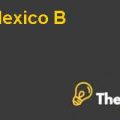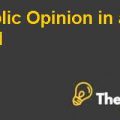Introduction
The exchange rate most importantfor any economy due to which government of any particular country has preferences over exchange rates. The policies of the government towards the country currency is prominent in most of the countries, while in some countries these policies are controversial.
The increase and decrease in the value of a country’s currency have a significant impact on the overall financial situation of the particular country. The increase in national currency value benefits by making it easier for the country while trading in other international currencies whereas, weakening currency value reduces this advantage. Having strong currency allows easy access to the other international markets for business transactions as it provides the opportunity to deal (buy or sell) in lower prices(Berg, 2010).
There are several risk management techniques that are useful for any particular government in order to overcome the risk associated with the exchange rate and make an entrance into international capital market effective. The risk management of exchange rate is an important part for every firm in a particular country related to their foreign currency exposure decision. The exposure to the exchange rate risk greatly impact the earnings and cash flows of the firms operating in a certain economy that consist of both business operations and transaction exposure. These techniques are also constructive for the firms that wants to access international markets(ITO Takatoshi, 2013).
Risk Management Techniques
Risk management techniques consist of:
- Identification of the kinds of exchange rate risk
- Risk Analysis and Evaluation
- Hedging strategy
- Forward exchange contracts
- Money market hedge
- Currency futures
- Value-at-risk (VaR) model
- Role of government in exchange risk management
- Monitoring and controlling risks
Identification of the kinds of exchange rate risk
The exchange rate can expose to several kinds of risk that directly impact the economy of any particular country. In addition to this, exposure to exchange affects the firm’s competitive position in their respective market, debt and equity ratio and also cash flows of a firm in a certain country. These risks include economic risk, transaction, operational and translation risk that adversely influence the value of the currency that needs continuous consideration of the country’s government in order to think about possible improvement that can upgrade the finance setting.
Furthermore, identification of the factors that contributed to the currency risk exposure is essential in order to reduce the chances of falling exchange rate and improving the likelihood of strengthening the national currency. However, there are several risk factors that government always considers are recession, term of trade, public debt, political steadiness, inflation rate and interest rate difference. These are the factors that affect the exchange rate, which results in drop and an escalation in the currency value(Berg(, 2010).
Analysis and Evaluation of Currency Risk
Thee xposure to exchange rate risk results in financial crisis in any country due to the change in the one currency price as compared to another currency. Even though it is not easy to forecast exchange rates with perfect correctness, but government or firms that are dealing in other currencies can measure fluctuations in the exchange rates to which they may expose. The evaluation of exchange risk is essential as it is very important for the investors to be familiar with the exposure to exchange rate risk and its management due to the fact that it can greatly impact their investments.
Exchange rate Risk Management Case Solution
Hedging for Exchange Risk Management
Hedging is the one of the most useful exchange rate risk management technique that reduces the chances of exposure. With the use of hedging strategies, firms can protect themselves against unexpected as well as anticipated fluctuation in exchange rates by entering into a financial contract. However, hedging provides an opportunity to limit the currency risk with the variations in the prices of a particular economy(Döhring, 2008).
The role government is vital in this regard as by focusing on the factors that are affecting the national currency, it can assist the firms operating in the country to manage their risk. There are several methods that can be used in order to hedge currency risk which include futures, forwards, swaps and options hedge. The hedging can be done by using different kinds of contracts to achieve specific goals. .............................
This is just a sample partial case solution. Please place the order on the website to order your own originally done case solution.










